The global precision wire drawing service market is valued at USD 109.3 million in 2025 and is expected to reach USD 171.3 million in 2035, expanding at a CAGR of 4.6% and growing by nearly 1.57X. The progression represents an absolute increase of USD 62.0 million in the first five years and USD 34.5 million in the following phase, with steady adoption across electronics, automotive, and medical sectors.
One distinct area of analysis is tolerance differentiation. Unlike commodity wire, the service market thrives on producing wires with exacting micrometer-level tolerances, surface uniformity, and mechanical strength. For medical device manufacturers, aerospace suppliers, and microelectronics producers, these factors justify higher pricing and stricter procurement standards. Tracking how service providers differentiate through advanced dies, coating systems, and electrochemical drawing processes offers a window into where premiums are captured and how global leaders maintain technological advantages. Material specialization represents another unique factor. While copper and aluminum wires dominate in consumer electronics and automotive harnesses, demand is rising for high-performance materials such as tungsten, stainless steel, and precious metals in surgical devices, sensors, and advanced industrial components. Providers capable of adapting their processes to handle diverse metallurgical characteristics will gain stronger market positioning, as these materials command higher value per unit of service.
Service integration also stands out as a differentiator. Precision wire drawing is increasingly offered alongside annealing, plating, or coating to ensure traceability, consistency, and ready-to-use products. End-users in electronics and healthcare prefer vertically integrated service providers to minimize outsourcing risks, reduce supply chain complexity, and ensure compliance with quality standards. That trend shifts competition from standalone service shops toward companies that provide bundled, process-complete offerings.
Intellectual property and proprietary process innovations further shape the landscape. Firms developing advanced die materials, optimized lubrication systems, and electrochemical drawing techniques enjoy long-term contracts and defensible margins. Such innovations reduce downtime, improve throughput, and ensure consistency at industrial scales. Comparing firms with IP-backed technologies against those competing on labor or cost efficiency highlights two divergent growth strategies.
The precision wire drawing service market demonstrates distinct growth phases with varying market characteristics and competitive dynamics. Between 2025 and 2030, the precision wire drawing service market progresses through its advanced manufacturing adoption phase, expanding from USD 109.3 million to USD 136.8 million with steady annual increments averaging 4.7% growth. This period showcases the transition from basic mechanical drawing processes to advanced multi-stage systems with enhanced precision control and integrated quality monitoring, becoming mainstream features.
The 2025-2030 phase adds USD 27.5 million to market value, representing 44% of total decade expansion. Market maturation factors include standardization of tolerance specifications, declining equipment costs for high-precision systems, and increasing customer awareness of premium wire drawing benefits, reaching 75-80% effectiveness in dimensional accuracy applications. Competitive landscape evolution during this period features established service providers like Brookfield Wire and Niehoff GmbH expanding their processing capabilities while new entrants focus on specialized electrochemical drawing solutions and enhanced surface quality technology.
From 2030 to 2035, market dynamics shift toward advanced customization and multi-sector deployment, with growth accelerating from USD 136.8 million to USD 171.3 million, adding USD 34.5 million or 56% of total expansion. This phase transition logic centers on universal high-precision systems, integration with automated quality inspection equipment, and deployment across diverse application scenarios, becoming standard rather than specialized manufacturing formats. The competitive environment matures with focus shifting from basic diameter reduction to comprehensive surface finish performance and compatibility with modern electronic assembly operations.
| Metric | Value |
|---|---|
| Market Value (2025) | USD 109.3 million |
| Market Forecast (2035) | USD 171.3 million |
| Growth Rate | 4.60% CAGR |
| Leading Wire Drawing Type | Mechanical Wire Drawing |
| Primary Application | Consumer Electronics Segment |
The precision wire drawing service market demonstrates strong fundamentals, with mechanical wire drawing systems capturing a dominant share through superior precision characteristics and cost-effective processing capabilities. Consumer electronics applications drive primary demand, supported by increasing miniaturization requirements and enhanced dimensional control solutions. Geographic expansion remains concentrated in developed markets with established manufacturing infrastructure, while emerging economies show accelerating adoption rates driven by electronics production projects and rising precision manufacturing activity.
Market expansion rests on three fundamental shifts driving adoption across electronics and industrial sectors. Miniaturization growth creates compelling advantages through precision wire drawing systems that provide comprehensive dimensional control with consistent surface quality, enabling manufacturers to achieve ultra-fine specifications and maintain electrical performance while ensuring reliable processing operations and justifying investment over basic drawing methods. Electronics manufacturing modernization accelerates as companies worldwide seek advanced wire processing systems that deliver operational precision directly to production operations, enabling cost reduction that aligns with quality expectations and maximizes manufacturing productivity. Component density increases drive adoption from electronics manufacturers requiring ultra-fine wire solutions that maximize space utilization while maintaining electrical performance during assembly and integration operations.
However, growth faces headwinds from raw material price variations that differ across wire suppliers regarding cost stability and supply chain reliability, potentially limiting margin consistency in price-sensitive manufacturing categories. Quality control complexity also persists regarding tolerance specifications and surface finish requirements that may increase processing standards in markets with demanding precision protocols.
The precision wire drawing service market represents a compelling intersection of manufacturing innovation, materials technology advancement, and precision processing optimization management. With robust growth projected from USD 109.3 million in 2025 to USD 171.3 million by 2035 at a 4.60% CAGR, this market is driven by increasing miniaturization trends, electronic component requirements, and industrial demand for ultra-fine wire formats.
The precision wire drawing service market's expansion reflects a fundamental shift in how electronics manufacturers and industrial facilities approach wire processing infrastructure. Strong growth opportunities exist across diverse applications, from consumer electronics operations requiring ultra-fine conductors to automotive facilities demanding high-strength wire components. Geographic expansion is particularly pronounced in Asia-Pacific markets, led by China (6.2% CAGR) and India (5.8% CAGR), while established markets in North America and Europe drive innovation and specialized segment development.
The dominance of mechanical wire drawing systems and consumer electronics applications underscores the importance of proven processing technology and dimensional reliability in driving adoption. Wire diameter consistency and surface quality remain key challenges, creating opportunities for companies that can deliver consistent performance while maintaining cost efficiency.
Primary Classification: The market segments by wire drawing type into Mechanical Wire Drawing, Chemical Wire Drawing, Electrochemical Wire Drawing, and Others categories, representing the evolution from basic mechanical reduction to advanced multi-stage processing formats for comprehensive dimensional control operations.
Secondary Breakdown: Application segmentation divides the precision wire drawing service market into Consumer Electronics, Automobile, Medical Devices, Industrial Equipment, Telecommunications, Aerospace & Defense, and Other sectors, reflecting distinct requirements for precision specifications, surface quality characteristics, and electrical performance.
Regional Classification: Geographic distribution covers North America, Europe, Asia Pacific, Latin America, and the Middle East & Africa, with developed markets leading innovation while emerging economies show accelerating growth patterns driven by electronics manufacturing programs.
The segmentation structure reveals technology progression from standard mechanical drawing toward integrated multi-stage platforms with enhanced precision and surface quality capabilities, while application diversity spans from consumer electronics to industrial facilities requiring comprehensive wire processing and dimensional accuracy solutions.
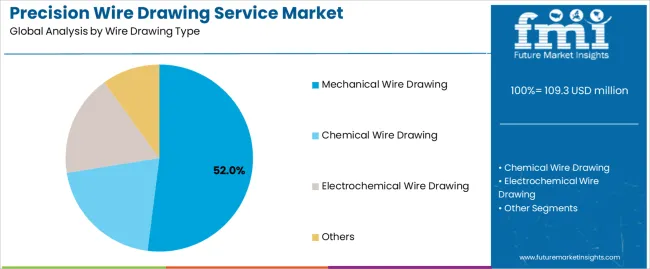
Mechanical Wire Drawing segment is estimated to account for 52% of the precision wire drawing service market share in 2025. The segment's leading position stems from its fundamental role as a critical component in wire processing applications and its extensive use across multiple electronics and industrial sectors. Mechanical wire drawing's dominance is attributed to its superior cost-effectiveness, including excellent dimensional control, reliable processing consistency, and balanced performance characteristics that make it indispensable for everyday wire manufacturing operations.
Market Position: Mechanical wire drawing systems command the leading position in the precision wire drawing service market through advanced die technology, including comprehensive diameter control, uniform surface finish, and reliable processing performance that enable service providers to deploy wire processing solutions across diverse application environments.
Value Drivers: The segment benefits from customer preference for proven processing methods that provide exceptional dimensional accuracy without requiring premium processing costs. Efficient manufacturing processes enable deployment in consumer electronics, automotive applications, and industrial wire processing where consistency reliability and cost efficiency represent critical selection requirements.
Competitive Advantages: Mechanical wire drawing systems differentiate through excellent diameter precision, proven surface quality, and compatibility with standard processing equipment that enhance wire performance while maintaining economical processing profiles suitable for diverse manufacturing applications.
Key market characteristics:
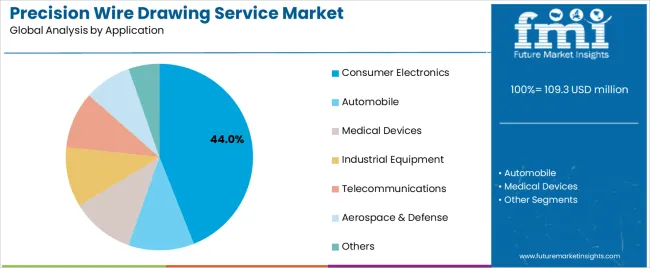
Consumer Electronics segment is projected to hold 44% of the precision wire drawing service market share in 2025. The segment's market leadership is driven by the extensive use of precision wire drawing in smartphone components, tablet devices, wearable electronics, and computer hardware, where ultra-fine wires serve as both electrical conductors and space-saving solutions. The consumer electronics sector's consistent demand for miniaturized wire components supports the segment's dominant position.
Market Context: Consumer electronics applications dominate the precision wire drawing service market due to widespread adoption of miniaturization solutions and increasing focus on device portability, power efficiency, and component integration that enhance product performance while maintaining compact form factors.
Appeal Factors: Electronics manufacturers prioritize dimensional precision, surface quality, and integration with automated assembly systems that enable coordinated deployment across multiple component requirements. The segment benefits from substantial device production growth and technological advancement that emphasize ultra-fine wire systems for portable electronics applications.
Growth Drivers: Electronics manufacturing programs incorporate precision wire drawing as standard components for smartphone assembly and wearable device production. At the same time, miniaturization initiatives are increasing demand for premium wire specifications that comply with assembly standards and enhance device performance.
Market Challenges: Material cost fluctuations and diameter tolerance requirements may limit deployment flexibility in ultra-price-sensitive markets or regions with varying quality requirements.
Application dynamics include:
Growth Accelerators: Electronics miniaturization drives primary adoption as precision wire drawing systems provide exceptional dimensional accuracy that enables component integration without electrical performance compromise, supporting device advancement and manufacturing efficiency that require ultra-fine wire formats. Technology development accelerates market expansion as manufacturers seek advanced processing solutions that maintain electrical properties during diameter reduction while enhancing surface quality through specialized drawing techniques and controlled processing environments. Quality standards increase worldwide, creating sustained demand for precision wire processing systems that complement manufacturing requirements and provide operational advantages in assembly efficiency.
Growth Inhibitors: Equipment cost complexity challenges differ across processing markets regarding capital investment and maintenance requirements, which may limit margin predictability and capacity planning in price-sensitive manufacturing categories with demanding affordability requirements. Technical complexity persists regarding tolerance control and surface finish standards that may increase processing costs in applications with strict dimensional protocols. Market fragmentation across multiple diameter specifications and material requirements creates compatibility concerns between different assembly systems and existing manufacturing infrastructure.
Market Evolution Patterns: Adoption accelerates in electronics and automotive sectors where precision benefits justify processing investments, with geographic concentration in developed markets transitioning toward mainstream adoption in emerging economies driven by manufacturing expansion and electronics production development. Technology advancement focuses on enhanced processing precision, improved equipment efficiency, and integration with automated quality control systems that optimize dimensional accuracy and processing consistency. The precision wire drawing service market could face disruption if alternative wire processing methods or material innovations significantly challenge traditional precision wire drawing advantages in manufacturing applications.
The precision wire drawing service market demonstrates varied regional dynamics with growth leaders including China (6.2% CAGR) and India (5.8% CAGR) driving expansion through electronics manufacturing growth and industrial modernization. Steady Performers encompass Germany (5.3% CAGR), Brazil (4.8% CAGR), the USA (4.4% CAGR), the UK (3.9% CAGR), and Japan (3.5% CAGR), benefiting from established manufacturing systems and advanced technology adoption.
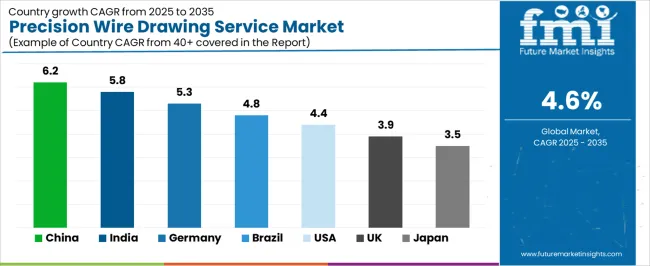
| Country | CAGR (2025-2035) |
|---|---|
| China | 6.2% |
| India | 5.8% |
| Germany | 5.3% |
| Brazil | 4.8% |
| USA | 4.4% |
| UK | 3.9% |
| Japan | 3.5% |
Regional synthesis reveals Asia-Pacific markets leading growth through electronics manufacturing expansion and industrial development, while European countries maintain steady expansion supported by specialized applications and quality requirements. North American markets show strong growth driven by automotive demand and industrial equipment upgrades.
China establishes regional leadership through massive electronics production capacity and comprehensive manufacturing modernization, integrating advanced precision wire drawing systems as standard components in smartphone assembly and consumer electronics operations. The country's 6.2% CAGR through 2035 reflects manufacturing expansion promoting electronics density and industrial infrastructure development that mandate the use of ultra-fine wire processing systems in production operations. Growth concentrates in major manufacturing centers, including Shenzhen, Shanghai, and Suzhou, where electronics facilities showcase integrated wire drawing systems that appeal to manufacturers seeking enhanced precision capability and international quality standards.
Chinese service providers are developing innovative precision wire drawing solutions that combine local manufacturing advantages with international quality specifications, including multi-stage processing and advanced surface finishing capabilities.
Strategic Market Indicators:
The Indian market emphasizes electronics manufacturing applications, including rapid industrial development and comprehensive technology expansion that increasingly incorporates precision wire drawing for consumer electronics production and automotive component applications. The country is projected to show a 5.8% CAGR through 2035, driven by massive manufacturing activity under Make in India initiatives and industrial demand for standardized, high-quality wire processing systems. Indian electronics facilities prioritize cost-effectiveness with precision wire drawing delivering operational efficiency through economical processing usage and reliable dimensional performance.
Technology deployment channels include major electronics manufacturers, automotive suppliers, and industrial equipment producers that support high-volume processing for domestic and export applications.
Performance Metrics:
The USA market emphasizes advanced precision wire drawing features, including innovative processing technologies and integration with comprehensive quality control platforms that manage automotive components, medical device applications, and aerospace manufacturing through unified processing systems. The country is projected to show a 4.4% CAGR through 2035, driven by manufacturing modernization under industrial automation trends and aerospace demand for premium, reliable wire processing systems. American manufacturers prioritize precision with wire drawing services delivering comprehensive dimensional control through enhanced tolerance capabilities and operational innovation.
Technology deployment channels include major automotive manufacturers, medical device companies, and aerospace contractors that support custom processing for premium operations.
Performance Metrics:
In Munich, Stuttgart, and Frankfurt, German manufacturing facilities and automotive suppliers are implementing advanced precision wire drawing systems to enhance component capabilities and support operational efficiency that aligns with quality protocols and manufacturing standards. The German market demonstrates sustained growth with a 5.3% CAGR through 2035, driven by automotive innovation programs and industrial investments that emphasize reliable wire processing systems for automotive and industrial applications. German manufacturing facilities are prioritizing precision wire drawing systems that provide exceptional dimensional accuracy while maintaining compliance with quality standards and minimizing processing complexity, particularly important in automotive component production and industrial equipment operations.
Market expansion benefits from industry 4.0 programs that mandate enhanced precision in manufacturing specifications, creating sustained demand across Germany's automotive and industrial sectors, where dimensional control and surface quality represent critical requirements.
Strategic Market Indicators:
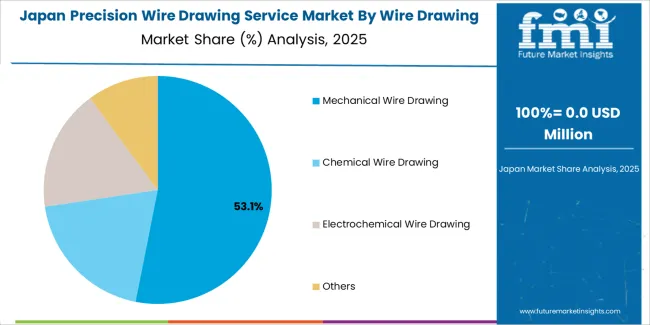
Japan's sophisticated manufacturing market demonstrates meticulous precision wire drawing deployment, growing at 3.5% CAGR, with documented operational excellence in electronics manufacturing and automotive applications through integration with existing quality control systems and precision manufacturing infrastructure. The country leverages engineering expertise in materials processing and equipment manufacturing to maintain market leadership. Manufacturing centers, including Tokyo, Osaka, and Nagoya, showcase advanced installations where precision wire drawing systems integrate with comprehensive quality platforms and inspection systems to optimize manufacturing performance and operational efficiency.
Japanese manufacturing facilities prioritize dimensional precision and process consistency in service selection, creating demand for premium wire drawing systems with advanced features, including ultra-fine diameter control and integration with automated quality protocols. The precision wire drawing service market benefits from established manufacturing infrastructure and willingness to invest in specialized processing technologies that provide superior dimensional accuracy and regulatory compliance.
Market Intelligence Brief:
Brazil's emerging precision wire drawing market emphasizes automotive manufacturing applications, including comprehensive industrial development and expanding electronics production that increasingly incorporates precision wire processing for automotive wiring harnesses and consumer electronics assembly. The country is projected to show a 4.8% CAGR through 2035, driven by significant manufacturing growth under industrial modernization initiatives and automotive demand for reliable, cost-effective wire processing systems. Brazilian manufacturing facilities prioritize operational efficiency with precision wire drawing delivering manufacturing optimization through competitive processing costs and consistent dimensional performance capabilities.
The precision wire drawing service market expansion is supported by major automotive manufacturers in São Paulo and Rio Grande do Sul, where precision wire drawing systems serve critical roles in vehicle electrical systems and component assembly operations. Brazilian service providers are developing localized processing capabilities that combine regional cost advantages with international quality standards, particularly targeting automotive OEMs and tier-one suppliers requiring consistent wire specifications.
Strategic Market Indicators:
Performance Metrics:
The UK market demonstrates focused precision wire drawing deployment, growing at 3.9% CAGR, with particular strength in automotive component manufacturing and aerospace applications through established engineering expertise and quality-focused manufacturing operations. The country's market development centers on specialized applications where precision wire drawing systems support critical component assembly in automotive electronics, aerospace wiring, and industrial equipment manufacturing. Major manufacturing regions, including the Midlands, Yorkshire, and Scotland, showcase integrated wire processing operations that serve automotive OEMs and aerospace contractors requiring exceptional dimensional control and traceability.
British manufacturing facilities emphasize quality assurance and regulatory compliance in precision wire drawing service selection, creating sustained demand for processing systems with advanced certification capabilities and documented performance characteristics. The precision wire drawing service market benefits from established relationships between service providers and major automotive manufacturers, including Jaguar Land Rover, Rolls-Royce, and automotive electronics suppliers requiring specialized wire processing for electric vehicle applications and advanced driver assistance systems.
Market Development Factors:
Strategic Positioning:
The precision wire drawing service market in Europe is projected to grow from USD 28.4 million in 2025 to USD 41.2 million by 2035, registering a CAGR of 3.8% over the forecast period. Germany is expected to maintain its leadership position with a 42.1% market share in 2025, declining slightly to 41.8% by 2035, supported by its automotive manufacturing excellence and major industrial centers, including Baden-Württemberg and North Rhine-Westphalia.
France follows with a 22.5% share in 2025, projected to reach 23.1% by 2035, driven by comprehensive aerospace manufacturing programs and electronics facility initiatives. The United Kingdom holds a 16.8% share in 2025, expected to maintain 17.2% by 2035 through established automotive sectors and industrial equipment adoption. Italy commands a 11.2% share, while Spain accounts for 5.9% in 2025. The Rest of Europe region is anticipated to gain momentum, expanding its collective share from 1.5% to 2.3% by 2035, attributed to increasing manufacturing development in Eastern European countries and emerging industrial programs implementing precision processing systems.
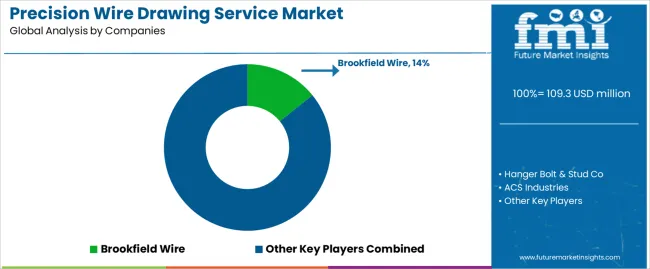
The precision wire drawing service market operates with moderate concentration, featuring approximately 15-22 participants, where leading companies control roughly 38-45% of the global market share through established processing networks and comprehensive technical service capabilities. Competition emphasizes dimensional precision, processing consistency, and cost efficiency rather than premium feature rivalry.
Market leaders encompass Brookfield Wire, Hanger Bolt & Stud Co, and ACS Industries, which maintain competitive advantages through extensive wire processing expertise, global service networks, and comprehensive technical support capabilities that create customer loyalty and support manufacturing requirements. These companies leverage decades of drawing technology experience and ongoing equipment investments to develop advanced wire processing systems with exceptional precision and surface quality features.
Specialty challengers include Niehoff GmbH, Bob Martin Company, and Zemetal, which compete through specialized application innovation focus and efficient processing solutions that appeal to electronics buyers seeking reliable performance formats and custom specification flexibility. These companies differentiate through operational efficiency emphasis and specialized market focus.
Market dynamics favor participants that combine consistent dimensional performance with advanced quality control support, including automated inspection and traceability capabilities. Competitive pressure intensifies as traditional wire manufacturers expand into precision drawing services. At the same time, specialized processing contractors challenge established players through innovative processing techniques and cost-effective production targeting emerging electronics segments.
| Item | Value |
|---|---|
| Quantitative Units | USD 109.3 million |
| Wire Drawing Type | Mechanical Wire Drawing, Chemical Wire Drawing, Electrochemical Wire Drawing, Others |
| Application | Consumer Electronics, Automobile, Medical Devices, Industrial Equipment, Telecommunications, Aerospace & Defense, Others |
| Regions Covered | North America, Europe, Asia Pacific, Latin America, Middle East & Africa |
| Countries Covered | China, India, Germany, Brazil, USA, UK, Japan, and 25+ additional countries |
| Key Companies Profiled | Brookfield Wire, Hanger Bolt & Stud Co, ACS Industries, Niehoff GmbH, Bob Martin Company, Zemetal |
| Additional Attributes | Dollar sales by wire drawing type and application categories, regional adoption trends across Asia Pacific, North America, and Europe, competitive landscape with specialized service providers and equipment manufacturers, customer preferences for dimensional precision and surface quality characteristics, integration with quality control equipment and manufacturing systems, innovations in drawing die technology and multi-stage processing systems, and development of specialized wire processing solutions with enhanced precision control and surface finishing features |
The global precision wire drawing service market is estimated to be valued at USD 109.3 million in 2025.
The market size for the precision wire drawing service market is projected to reach USD 171.3 million by 2035.
The precision wire drawing service market is expected to grow at a 4.6% CAGR between 2025 and 2035.
The key product types in precision wire drawing service market are mechanical wire drawing, chemical wire drawing, electrochemical wire drawing and others.
In terms of application, consumer electronics segment to command 44.0% share in the precision wire drawing service market in 2025.






Full Research Suite comprises of:
Market outlook & trends analysis
Interviews & case studies
Strategic recommendations
Vendor profiles & capabilities analysis
5-year forecasts
8 regions and 60+ country-level data splits
Market segment data splits
12 months of continuous data updates
DELIVERED AS:
PDF EXCEL ONLINE
Precision Planting Market Size and Share Forecast Outlook 2025 to 2035
Precision Bearing Market Size and Share Forecast Outlook 2025 to 2035
Precision Laser Engraving Machines Market Size and Share Forecast Outlook 2025 to 2035
Precision Analog Potentiometer Market Size and Share Forecast Outlook 2025 to 2035
Precision Blanking Dies Market Size and Share Forecast Outlook 2025 to 2035
Precision Components And Tooling Systems Market Size and Share Forecast Outlook 2025 to 2035
Precision Chemicals Market Size and Share Forecast Outlook 2025 to 2035
Precision Fermentation Ingredients Market Size and Share Forecast Outlook 2025 to 2035
Precision-Fermented Casein for QSR Pizza Cheese Market Analysis - Size, Share, and Forecast Outlook 2025 to 2035
Precision Ruminant Minerals Market Analysis - Size and Share Forecast Outlook 2025 to 2035
Precision Forestry Market Size and Share Forecast Outlook 2025 to 2035
Precision Stainless Steel Market Size and Share Forecast Outlook 2025 to 2035
Precision Machine For Polymers Market Size and Share Forecast Outlook 2025 to 2035
Precision Aquaculture Market Size and Share Forecast Outlook 2025 to 2035
Precision Fermented Functional Lipids Market Analysis Size and Share Forecast Outlook 2025 to 2035
Precision Gearbox Machinery Market Trends and Forecast 2025 to 2035
Precision Cancer Imaging Market Growth - Industry Trends & Forecast 2025 to 2035
Precision Poultry Nutrition Market – Growth, Demand & Livestock Trends
Precision Livestock Farming Market - Trends & Forecast 2034
Precision Agriculture Market

Thank you!
You will receive an email from our Business Development Manager. Please be sure to check your SPAM/JUNK folder too.
Chat With
MaRIA